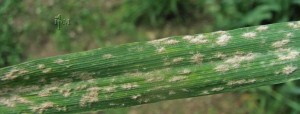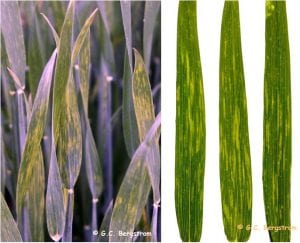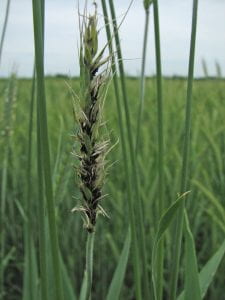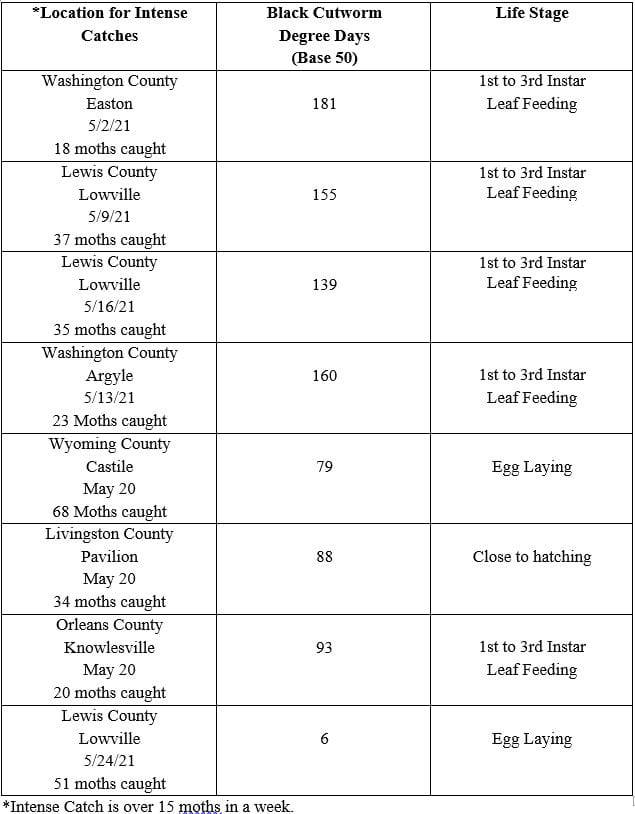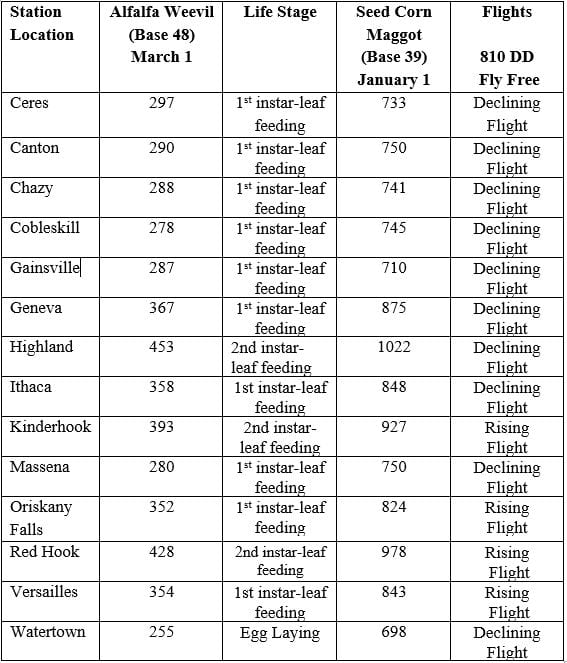NYS IPM Weekly Field Crops Pest Report
View from the Field
Cereal Leaf Beetle
Mike Stanyard (CCE Northwest Dairy and Field Crops Team) reports finding cereal leaf beetle eggs in small grains. These are at low levels currently. Be on the watch for larvae. This is what they look like:
If you find them in your fields, we would like to collect some larvae for a study on parasitism and biological control.
Alfalfa Weevil
Alfalfa Weevil damage was monitored this week. It was at low levels. Normally the first cutting of alfalfa will control alfalfa weevil with some exceptions.
Powdery Mildew
Powdery Mildew has been reported over the threshold on small grains. The following photo is the mildew on leaves. Here is a decision tool to determine if a field needs to be treated with a fungicide: https://fieldcrops.cals.cornell.edu/small-grains/diseases-small-grains/disease-management/guidelines-wheat-fungicide-decisions/
Wheat Spindle Streak Mosaic
Dr. Gary Bergstrom (Extension Field Crops Pathologist-Professor) reports finding low levels of wheat spindle streak mosaic in wheat. For more information, please view the following article:
Photo by Dr. Gary Bergstrom
Loose Smut
Aaron Gabriel (CCE Capital District) reports finding a high infestation of loose smut on feed barley in Washington County. For more information, view the following publication: https://extension.umaine.edu/publications/1016e/
Black Cutworm Flight Migration Alerts
Black cutworm migrations on weather fronts have increased this last week with some very high moth captures in western and northern NY. An intense catch is more than 15 moths caught in a trap in a week. The following table is the biofix date for each intense catch. We can predict using a degree-day model with relative accuracy when black cutworm larvae may be active in fields near the trap. Currently, the moths are laying eggs.
True Armyworm Flight Migration Alerts
True armyworm migrations on weather fronts have been low with the exception of one intense moth capture in Pavilion, NY. An intense catch is more than 15 moths caught in a trap in a week. We can predict a degree-day model with relative accuracy when true armyworm larvae may be active in fields near the trap. Currently, the moths are laying eggs.
Fusarium Head Blight Update for NY, 5/21/2021
Gary Bergstrom, Extension Plant Pathologist, Cornell University
Much of the winter malting barley in New York reached full head emergence in the past several days when the Fusarium Risk Assessment Map (http://www.wheatscab.psu.edu/ ) indicated low risk of Fusarium head blight (FHB) across the state. Maximal suppression of FHB and grain contamination by deoxynivalenol (DON) mycotoxin results when fully emerged heads of winter malting barley are sprayed with DMI (FRAC Group 3) containing fungicides Caramba, Prosaro, or Miravis Ace (latter includes FRAC Group 7 fungicide). A heads-emerged spray with these fungicides also protects upper leaves against fungal leaf blotches, powdery mildew, and rusts. Foliar sprays of any of these three products up to seven days after head emergence may still result in significant FHB and DON suppression. We are currently observing low levels of scald and powdery mildew in winter barley.
Much of the winter wheat in New York is at boot stage and is expected to initiate flowering during the first week in June. The DMI (FRAC Group 3) containing fungicides Caramba, Prosaro, or Miravis Ace (latter includes a FRAC Group 7 fungicide) are the most effective fungicides for suppression of FHB and DON contamination when applied at flowering (emergence of yellow anthers on heads). A flowering application of these fungicide products should be based on Fusarium head blight (FHB) risk as well as the risks of powdery mildew, rusts, and fungal leaf blotches in the upper canopy based on scouting of individual fields. There is an application window of approximately 7 days from the beginning of flowering in which reasonable FHB and DON suppression can be expected. Severe powdery mildew has been observed in some mildew-susceptible varieties. Check the Fusarium Risk Assessment Tool (http://www.wheatscab.psu.edu/ ) and your local weather forecast frequently as your winter wheat crop approaches heading and flowering.
NYS IPM Field Corn Pheromone Trapping Data
Black Cutworm Captures (May 16-23)
True Armyworm Captures (May 16-23)
Degree Day Models for Alfalfa Weevil and Seed Corn Maggot
Clipboard Checklist
Keith Waldron, NYS IPM
General
*Walk fields to check tile flow, check and clear drainage outlets. Look for line breaks
*Note and record location of wet areas on field maps or aerial photo for future tiling considerations and crop decisions, check for areas of soil erosion
*Pre-plant weed evaluation, timing cultivation and/or pre-plant weed management
*Watch for early season weeds: winter annuals, chickweed, henbit, field penny cress, shepherd’s purse, giant and common ragweed, purple deadnettle, lambsquarters, redroot pigweed, velvet leaf, Pennsylvania smartweed, common sunflower, quackgrass, foxtail
Alfalfa:
*Evaluate established legume stands for winter damage (thinning stand, frost heave, Brown root rot), determine average alfalfa stand count adjust crop plans if necessary
*Monitor for alfalfa weevil, crown or foliar diseases
*Monitor new seedings for Pythium blight and Phytopthora Root Rot.
*Monitor for Alfalfa Snout Beetle (In Oswego, Jefferson, Cayuga, Wayne, Lewis, St. Lawrence, Clinton, Essex, and Franklin counties)
Small Grains:
*Monitor winter grain fields for over wintering survival (snow mold and other cold injury issues), weed issues (such, as winter annuals, corn chamomile and chickweed), growth stage, number of tillers, foliar diseases (powdery mildew, rusts)
*Check stands for soilborne virus diseases, Wheat spindle streak mosaic and Soilborne wheat mosaic, check for signs of powdery mildew or other maladies, cereal leaf beetle, weed escapes, goose damage
Corn:
*Prepare land and plant corn as conditions allow
*Pre-plant weed evaluation, timing cultivation and/or pre-plant weed management
*Emergence: assess stand, population count
Soybeans:
*Prepare land and plant soybeans as conditions allow
*Pre-plant weed evaluation, timing cultivation and/or pre-plant weed management
Pastures:
*Check and mend fences as needed.
*Check crop growth
*Monitor fields for invasive species, plants harmful to livestock
*Review/Plan rotation system
Equipment:
*Remove / clean soil and crop debris from equipment
*Arrange for custom weed control or check your own application or cultivator equipment for repairs.
*Carry appropriate / necessary NYS DEC and EPA required documents: (pesticide applicators license, pesticide labels, MSDS sheets, etc.) with application equipment
*Calibrate:
-planting equipment – maintain records on planting rate per field
-manure spreaders – maintain records on amount spread per field
-pesticide application equipment – Check nozzles, pumps, etc., recalibrate pesticide application equipment before use.
Storage:
* Check stored grain bins for temperature, moisture and signs of mold and insects. Aerate, core, transfer grain or treat as necessary
*Check forage allocation and anticipate feed program adjustments as forages from previous year are used up
*Plan where forages should be stored for optimum allocation next feeding season



